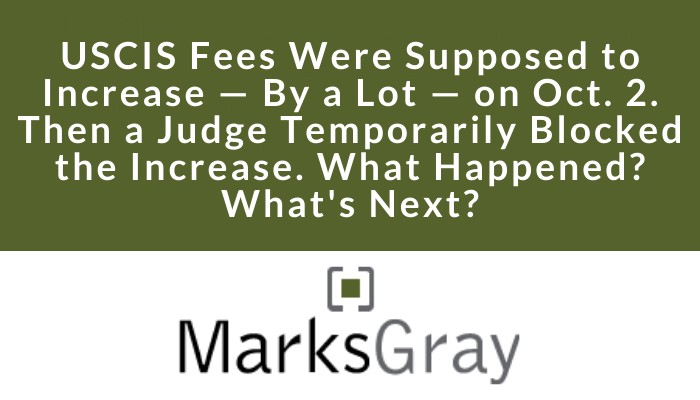After several organizations filed lawsuits against USCIS to challenge and stop the significant fee increases, on Tuesday, September 29, 2020, a federal judge temporarily blocked USCIS’ fee increase action.
The order came just three days before the new fees were scheduled to go into effect on October 2, 2020.
The judge questioned the validity of the fee increase and its effect on applicants. The order calls for the fees increase to be blocked across the country.
We expect that USCIS will appeal this order and that in the near future we will see a USCIS fee increase implemented. Why? Because USCIS will continue to argue that “current fees do not recover the full cost of providing adjudication and naturalization services.”
The fee increase rule is 576 pages long and includes some reductions in fees as well. Some key points include:
- Increased fees by a weighted average of 20 percent
- Higher and petition-specific fees for H-1B, L-1, O-1, and other employment-based nonimmigrant filings
- Increased fees for adjustment applications and ancillary benefits
- And nearly doubled fees for naturalization applications
Here is a partial list of potential fee changes that impact employment-based and other immigration applications:
If USCIS’ fee increase proposal goes into effect, there will also be new immigration forms and adjustments to processing time.
Below are some of the biggest changes to note:
Adjustment of Status (AOS) Applicants
The Form I-485 fee of $1,130 will apply to ALL applicants, including children under the age of 14 filing with their parents. Currently, they pay a slightly lower fee. AOS applicants will also be required to pay separate fees for Form I-765, Application for Employment Authorization ($550), and Form I-131, Application for Travel Document ($590), filed in connection with applications for adjustment of status. The total filing fees costs of an AOS application package increases to $2,270.
Biometrics Fee
With some exceptions, USCIS has eliminated the separate biometrics service fee of $85 for many application types and instead the filing fee for most forms incorporates the cost of biometric services that were typically associated with that form. For example, the biometrics fee will now be included as part of the base adjustment of status filing fee for Form I-485.
Premium Processing
Although the rule did not change the $1,440 fee for premium processing, it did change the premium processing time frame from 15 calendar days to 15 business days. USCIS considers “business days” as those days on which the federal government is open for business. Business days do not include weekends, federally observed holidays, or the days on which federal government offices are closed (including, but not limited to, closures due to inclement weather or national emergencies).
A Few of the New Forms That Could Become Effective:
- Petition for Nonimmigrant Worker: H-1B or H-1B1 Classifications (Form I-129H1)
- Petition for Nonimmigrant Worker: L Classification (Form I-129L)
- Petition for Nonimmigrant Worker: O Classification (Form I-129O)
- Application for Nonimmigrant Worker: E and TN Classification (Form I-129E&TN)
- Application for Employment Authorization (Form I-765)
For ongoing updates, frequently check the USCIS website.
To stay up-to-date on business immigration news, subscribe to our Immigration News Bites below.
